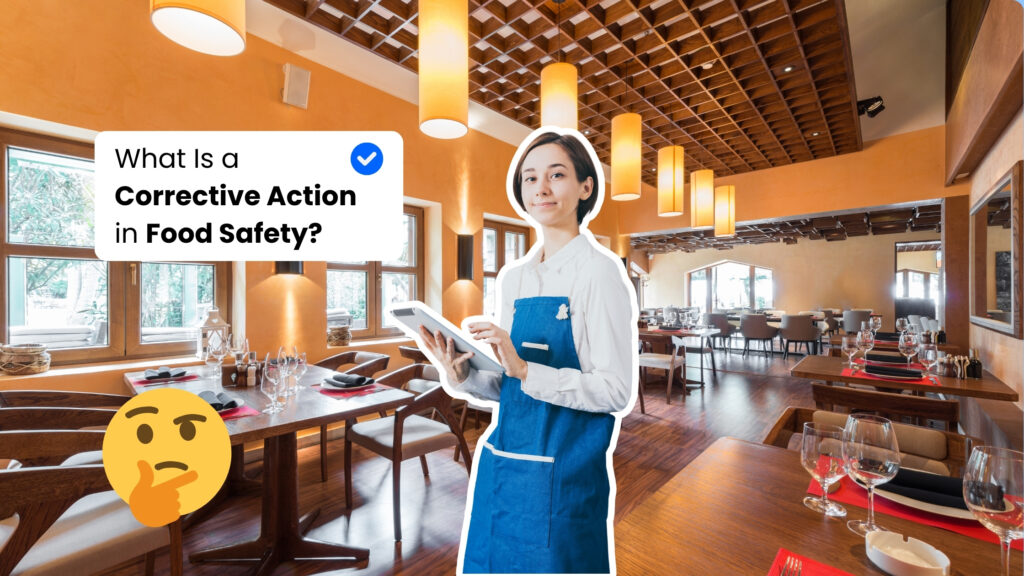What Is a Corrective Action in Food Safety (and Why It Must Be Logged Digitally)

What Is a Corrective Action in Food Safety?
A corrective action in food safety is a specific response to identified non-compliance issues during food safety audits. These actions are immediate steps taken to fix problems and prevent food safety risks.
Key elements of corrective actions include:
- Immediate Resolution: Quick responses to issues like temperature control failures or cross-contamination risks
- Risk Prevention: Steps to stop similar issues from happening again
- Documentation: Detailed records of what went wrong and how it was fixed
Proper corrective actions protect both customers and businesses. They help maintain food safety regulatory compliance by addressing potential hazards before they cause harm. Digital documentation of these actions creates a clear audit trail, demonstrating your commitment to food safety standards.
A strong corrective action system shows food safety auditors that your business takes compliance seriously and can handle issues professionally.
What Is an Example of a Corrective Action in a Restaurant?
Temperature control violations in cold storage units represent a critical food safety risk. A practical corrective action involves:
1. Immediate Response
- Check current temperature readings
- Move affected food items to functioning units
- Adjust thermostat settings
- Contact maintenance for repairs
2. Digital Documentation
- Record initial temperature breach
- Log corrective steps taken
- Note time and date of resolution
- Track follow-up monitoring
Restaurant managers using digital audit readiness tools can set automated temperature alerts, create instant violation reports, and maintain comprehensive compliance records. These systems enable quick identification of recurring issues and help establish preventive measures.
A digital food safety system tracks corrective actions through:
- Real-time monitoring dashboards
- Automated compliance checklists
- Time-stamped photo evidence
- Detailed audit trails
How Do You Identify Corrective Actions?
Food safety audits are the main way to find out what corrective actions are needed. These thorough assessments uncover issues with compliance, potential dangers, and areas that need immediate attention.
What Do Professional Food Safety Compliance Services Assess?
Professional food safety compliance services conduct thorough assessments of:
- Food storage practices
- Temperature control systems
- Staff hygiene protocols
- Cross-contamination prevention measures
- Equipment maintenance standards
How Does Regular Monitoring Help?
Regular monitoring through daily checklists and routine inspections helps detect issues before they escalate. Digital monitoring systems track critical control points and alert staff when measurements fall outside safe parameters.
What Does a Structured Audit Process Include?
A structured audit process includes:
- Visual Inspections: Physical examination of facilities and practices
- Documentation Review: Analysis of existing records and procedures
- Staff Interviews: Assessment of employee knowledge and compliance
- Environmental Testing: Microbiological sampling and surface testing
These comprehensive evaluations create a clear picture of areas requiring corrective measures, enabling targeted improvements in food safety practices.
What Are the 5 Steps of a Corrective Action?
A systematic approach to corrective actions ensures effective food safety compliance management. Here are the five essential steps:
1. Immediate Response
- Stop unsafe food handling practices
- Isolate affected products
- Notify relevant staff members
2. Root Cause Analysis
- Investigate the source of the issue
- Review current procedures
- Identify contributing factors
3. Action Plan Development
- Create specific solutions
- Set clear timelines
- Assign responsible personnel
4. Implementation
- Execute planned corrective measures
- Train staff on new procedures
- Monitor initial results
5. Verification
- Test the effectiveness of actions
- Document all changes
- Schedule follow-up inspections
Digital documentation streamlines this process through automated tracking and real-time updates. Food safety inspection records become instantly accessible, allowing managers to verify corrective actions and maintain compliance standards efficiently.
A digital system helps prevent recurring issues by creating a searchable database of past corrective actions and their outcomes. This data-driven approach strengthens food safety compliance protocols and supports continuous improvement efforts.
How Can Food Safety Management Software Help With Managing Corrective Actions?
Food safety management software transforms corrective action tracking from a manual burden into a streamlined digital process. Digital systems automate documentation, send real-time alerts for non-compliance issues, and maintain detailed audit trails.
Key benefits of digital food safety compliance tools:
- Instant Access: View corrective action records from any device
- Automated Tracking: Set reminders for follow-up actions
- Error Reduction: Standardised forms eliminate incomplete documentation
- Data Analysis: Identify recurring issues through trend reporting
Squizify’s food safety management platform delivers these capabilities through:
- 24/7 cloud-based access
- Customisable digital checklists
- Automated temperature monitoring
- Real-time compliance reporting
Try Squizify to simplify your corrective action management and strengthen your food safety compliance programme. Book a demo today.